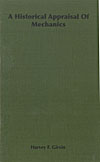
|
A Historical Appraisal of Mechanics [Girvin, 2007]
|
Text extracted from opening pages of book: INTERNATIONAL TEXTBOOKS IN CIVIL ENGINEERING A HISTORICAL APPRAISAL OF MECHANICS T HAS BEEN SAID that no man is civilized or mentally adult until he realizes that the past, the present, and the future are indivisible. Foreword All branches of engineering rest upon a foundation of mechanics. To appreciate the present and to plan for the future, one must have an understanding of the past. It is to be regretted that so little attention has been given in the literature of engineering to the historical aspects of mechan ics, too few writers realizing that a study of the past has a bearing on the present and future. In this book, the author has endeavored to include factual historical material which should prove helpful to students and workers in technology who are interested in the evolution of mechanics. * Mechanics is an old branch of learning. It is traced in this treatise to the days when the Greeks dominated all fields of learning, stressing the speculative and the accepted. Aristotle and Archimedes made significant contributions to mechanics of ancient times, the Bacons in the Medieval period, and Leonardo da Vinci and Copernicus during the Renaissance. Galileo, the creator of modern science, Descartes, Huygens, and Isaac Newton played a most impor tant role in changing emphasis from the speculative to the factual, from the accepted to the analytical, and from the deductive type of, reasoning to the inductive type. Experi mentation and analysis found outlets in the study of the mechanics of materials and led to a practical theory of elasticity. Then followed graphical statics, photo-elasticity, theory of redundant structures, and other new concepts, leading to modern engineering mechanics. The major engineering societies particularly the Ameri can Society of Mechanical Engineers, through its Applied Mechanics Division and several of the leading American manufacturers are now focusing the attention of engineers upon the importance of mechanics in connection with the solution of practical problems. While mechanics has at all times been considered a basic subject in engineering educa-JUL121949 FOREWORD . tapji^ recent years have witnessed special attention by engi tylfcfiihg colleges to graduate and research programs in this important branch of learning. Engineers and scientists are indebted to Professor Harvey Frank Girvin for an able and accurate presentation of the history of mechanics and of its relation to engineering educa tion. A. A. POTTER Dean of Engineering Purdue University Lafayette, Indiana November, 1947 Contents Page FOREWORD V Part I The Creation of Science and Scientific Thinking Chapter 1 INTRODUCTION 1 Interest in history of science The scope of Mechanics History of science parallels the development of mankind Man begins to create and plan Why science was developed Crude arithmetic appears Greek domination of science Mechanics and general science. Chapter 2 EARLY GREEK PHILOSOPHY 15 The speculative method of the Greeks Aristotle studies motion Archimedes the thinker Archimedes discovers the principle of buoyancy Archimedes 7 writings Archimedes and the lever The contributions of Archimedes to Mechanics. - Chapter 3 MEDIEVAL PERIOD: 500-1500 29 Religion and science Moorish culture in Spain Roger Bacon, the prophet of Oxford Roger Bacon and Francis Bacon. Part II Scientific Thought Begins to Function Charter 4 THE RENAISSANCE: 1400-1600 47 Why the Greeks failed Aristotle reestablished by Magnus and Aquinas Beginning of the revolt against Scholasticism The causes of the scientific renaissance Beginning of the renaissance Leonardo da Vinci, a man with an open mind Copernicus and his new planetary theory. Chapter 5 THE BEGINNING OF THE MODERN PERIOD ... 63 Further progress in the fundamentals of Mechanics Writings by Stevinu& The inclined plane The parallelogram of forces Stevinus 7 work in hydrostatics Basic statics completed. Chapter 6 DYNAMICS, THE SCIENCE OF MOTION 75
|
Price: $29.00
Buy Product Online | Visit Store Home
|

